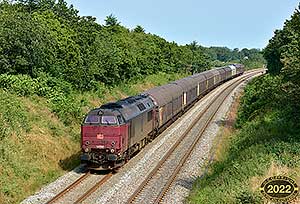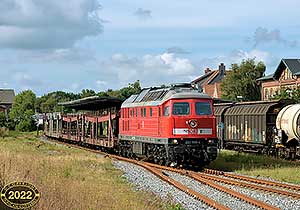80 Fredericia - Esbjerg
18 photos
updated : 2016-07-05
The double track Line 80 runs from east to west across the Jutland peninsula and hadn't been electrified at the time these pictures were taken. The route normally saw lots of DMUs and very few locos but for two brief periods in the summers of 2014 and 2015 there were big diesels on diverted international freights as well.
82 Bramming - Tønder
8 photos
updated : 2016-07-05
Line 82 is a sleepy single-track rural route linking Bramming, just east of Esbjerg, with Tønder, just north of the German border. It normally only sees DMUs but for two brief periods in the summers of 2014 and 2015 there were Danish and German diesels on diverted international freights a well.
Class MZ
12 photos
updated : 2016-07-05
The MZ was the standard Danish main line diesel of the 1970s and 1980s but privatisation, electrification and the headlong rush to operate all passenger trains with DMUs drastically reduced their numbers. DB Cargo still had six available for the Esbjerg freight diversions in 2014 and 2015.
Class 232/233 [DB]
9 photos
updated : 2016-07-05
The Soviet built DB Class 232 Co-Co diesel-electrics were originally built for DR but migrated westwards after German re-unification. They weren't regular visitors to Denmark but did see use on diverted freights between the Hamburg area and Esbjerg in the summers of 2014 and 2015.
Denmark isn't an obvious destination for railway photography with little dramatic scenery and few loco hauled trains. However, it was worth visiting Jutland in July 2014 and July 2015, when freight traffic to Germany was diverted via Esbjerg and Tønder with diesel haulage.
The first railway in Denmark, linking Copenhagen with Roskilde opened in 1847 and, like other early lines in the country, was built and operated by a private company. Following the failure of one such company in 1867, the state intervened and over the next quarter century acquired most of the privately owned railways, as well as building new lines itself. The national operator, DSB, has been in existence since those days but was split into separate passenger, freight and infrastructure operations in the late 1990s. The passenger operator retained the DSB name while the freight operator was acquired by DB. Some passenger services have since been franchised to other operators.
Denmark consists of the Jutland peninsula, stretching north for about 300km from the German border, together with 3 large islands and a number of smaller ones. The relatively flat nature of the Danish countryside lent itself to railway construction but links between the islands and with Jutland relied on ferries until the end of the 20th Century. The opening of the Storebælt link in 1998 finally connected all the major centres of population within Denmark by rail. The Øresund link connected Denmark to Sweden by rail for the first time in 2000, enabling through running between the Norwegian and Swedish railways and the rest of Europe via Denmark.
DSB dieselised from the early 1960s onwards with main line electrification at 25kV 50Hz AC only getting underway in the 1980s. So far only a few major routes have been completed, with others in progress or planned. Most passenger services have been operated by DMUs since the 1990s with EMUs taking over when lines are electrified. It was possible to find a few diesel hauled passenger trains in the Copenhagen area until recently but these have now ceased.
The majority of freight workings are concentrated on the electrified route linking Sweden and Germany via Copenhagen, Odense, Fredericia and Padborg. These trains are usually worked by modern multi-system electric locos equipped for the Swedish and German 15kV and Danish 25kV systems. Much of the network sees little freight traffic and DB Cargo only needs 6 main line diesels of Class MZ to operate its services away from the electrified network. Several independent operators also run freight trains in Denmark, often using older ex-DSB locomotives of Classes MX and MY but none have more than a handful of locomotives.
Denmark consists of the Jutland peninsula, stretching north for about 300km from the German border, together with 3 large islands and a number of smaller ones. The relatively flat nature of the Danish countryside lent itself to railway construction but links between the islands and with Jutland relied on ferries until the end of the 20th Century. The opening of the Storebælt link in 1998 finally connected all the major centres of population within Denmark by rail. The Øresund link connected Denmark to Sweden by rail for the first time in 2000, enabling through running between the Norwegian and Swedish railways and the rest of Europe via Denmark.
DSB dieselised from the early 1960s onwards with main line electrification at 25kV 50Hz AC only getting underway in the 1980s. So far only a few major routes have been completed, with others in progress or planned. Most passenger services have been operated by DMUs since the 1990s with EMUs taking over when lines are electrified. It was possible to find a few diesel hauled passenger trains in the Copenhagen area until recently but these have now ceased.
The majority of freight workings are concentrated on the electrified route linking Sweden and Germany via Copenhagen, Odense, Fredericia and Padborg. These trains are usually worked by modern multi-system electric locos equipped for the Swedish and German 15kV and Danish 25kV systems. Much of the network sees little freight traffic and DB Cargo only needs 6 main line diesels of Class MZ to operate its services away from the electrified network. Several independent operators also run freight trains in Denmark, often using older ex-DSB locomotives of Classes MX and MY but none have more than a handful of locomotives.




 options
options hide options panel
hide options panel


![Class 232/233 [DB]](i/14-D-3835-t.jpg)



